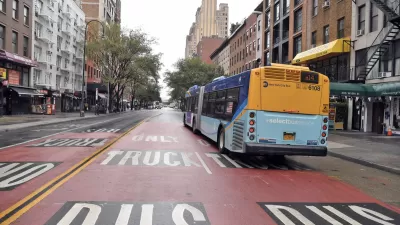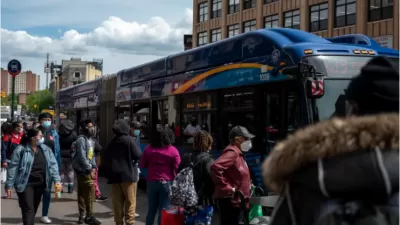Bowing to pressure from business interests, the agency says it won’t build a full busway on Fordham Road.

The New York City Department of Transportation (NYCDOT) is backing out of plans to build a busway on Fordham Road after encountering opposition from local business improvement districts (BIDs) that claim the busway would harm local businesses that “rely on car-dependent customers” and that have won support from local institutions such as the Bronx Zoo and St. Barnabas Hospital. Writing in Streetsblog NYC, Dave Colon points out that “A litany of surveys debunk this claim — including one this past March that found just 6 percent of people who drive to Little Italy on Arthur Avenue oppose a busway.”
According to Colon, the revised plan, which will “shift existing bus lanes away from the curb and extend them by several blocks” instead of a full busway, “will provide the least benefit for long-suffering bus riders.” City Council Member Pierina Sanchez expressed concern that the new plan won’t offer “significant improvements” in travel times. “DOT predicts a 20-percent bus speed improvement from the offset bus lanes versus a 30-percent speed improvement from a busway, according to a DOT spokesperson, who added that every project is unique, and as such cannot be compared to others.”
In a petition, the Riders Alliance calls on the Bronx Zoo and New York Botanical Garden to “stop fighting against better bus service now and use their substantial power to amplify riders’ demand for a busway.”
FULL STORY: DOT Nixes Fordham Road Busway Due To ‘Community Concerns’

Alabama: Trump Terminates Settlements for Black Communities Harmed By Raw Sewage
Trump deemed the landmark civil rights agreement “illegal DEI and environmental justice policy.”

Planetizen Federal Action Tracker
A weekly monitor of how Trump’s orders and actions are impacting planners and planning in America.

How Atlanta Built 7,000 Housing Units in 3 Years
The city’s comprehensive, neighborhood-focused housing strategy focuses on identifying properties and land that can be repurposed for housing and encouraging development in underserved neighborhoods.

In Both Crashes and Crime, Public Transportation is Far Safer than Driving
Contrary to popular assumptions, public transportation has far lower crash and crime rates than automobile travel. For safer communities, improve and encourage transit travel.

Report: Zoning Reforms Should Complement Nashville’s Ambitious Transit Plan
Without reform, restrictive zoning codes will limit the impact of the city’s planned transit expansion and could exclude some of the residents who depend on transit the most.

Judge Orders Release of Frozen IRA, IIJA Funding
The decision is a victory for environmental groups who charged that freezing funds for critical infrastructure and disaster response programs caused “real and irreparable harm” to communities.
Urban Design for Planners 1: Software Tools
This six-course series explores essential urban design concepts using open source software and equips planners with the tools they need to participate fully in the urban design process.
Planning for Universal Design
Learn the tools for implementing Universal Design in planning regulations.
Caltrans
Smith Gee Studio
Institute for Housing and Urban Development Studies (IHS)
City of Grandview
Harvard GSD Executive Education
Toledo-Lucas County Plan Commissions
Salt Lake City
NYU Wagner Graduate School of Public Service





























